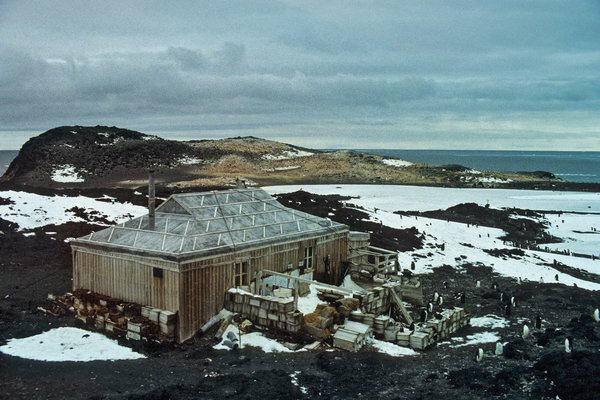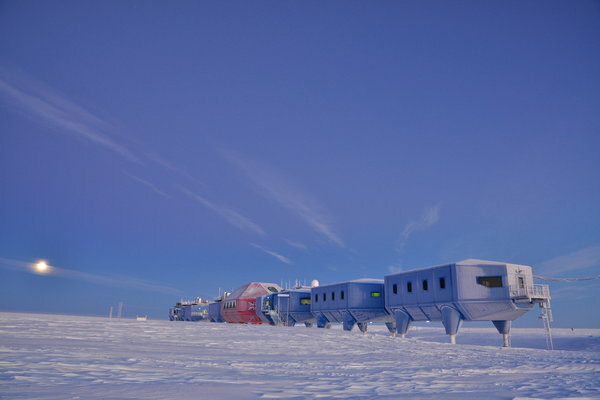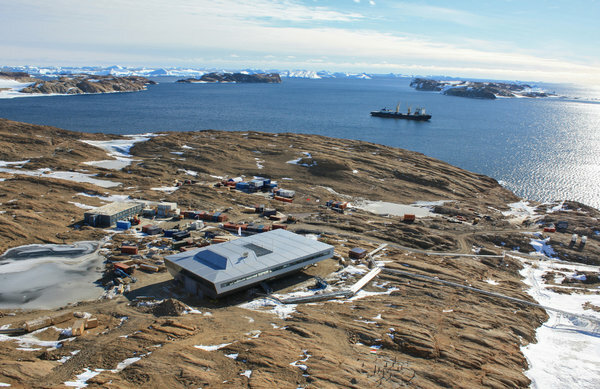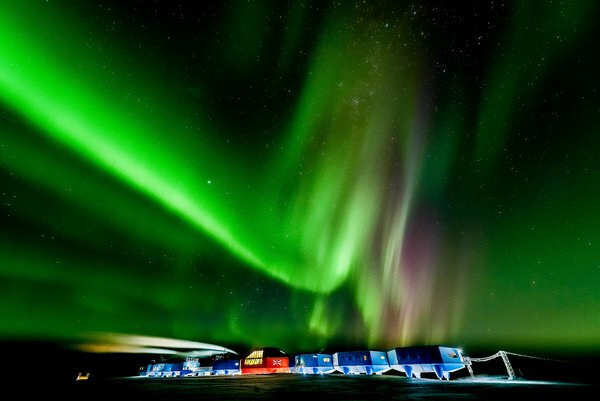
Who said a polar research base had to be ugly? Gradually, designers are rethinking how to build for the world’s harshest environment.

By John Gendall
Representatives from Brazil’s scientific community and government will head to Antarctica this month to inaugurate its new Comandante Ferraz Research Station, which replaces a facility lost to fire in 2012. The two low-slung buildings, designed by Estudio 41, a Brazilian architecture firm, house laboratories, operational support and living quarters — and could be mistaken for an art museum or a boutique hotel.
“Brazil is a tropical country, so we were not used to these conditions,” said Emerson Vidigal, a principal at the firm.
“These conditions” include temperatures that drop below minus 60 degrees Fahrenheit and winds that reach 100 miles per hour.
Throughout the 20th century, architecture in Antarctica was a pragmatic and largely makeshift affair, focused on keeping the elements out and the occupants alive. In 1959, the Antarctic Treaty dedicated the continent to research. Since then scientists have come in growing numbers and with ever more complex needs. Construction in Antarctica, long the purview of engineers, is now attracting designer architects looking to bring aesthetics — as well as operational efficiency, durability and energy improvements — to the coldest neighborhood on Earth.
“As architects, we are concerned with human comfort, so we set out to create a kind of atmosphere that would promote well-being,” Mr. Vidigal said.
When British explorers built one of the first permanent structures there, in 1902, they insulated it with felt and clad it in wood. The hut was “so draughty and cold in comparison with the ship,” Ernest Shackleton, one of the crew members on that expedition, recalled, “that it was, during the first year, never used for living quarters.” As accumulating snow rendered the door impassable, the crew resorted to using a window to come and go.


That sense of improvisation continued for decades. In 1956, the Royal Society founded Halley Research Station, but the facility was covered in snow by 1961 and was shut down in 1968. A replacement, Halley II, was reinforced with steel supports, but its life span was even shorter, from 1967 to 1973. Halley III lasted for 11 years, Halley IV for nine, and Halley V for nearly 15, with each rebuilding effort presenting a costly and operationally complex undertaking.
When, in 2005, Halley needed rebuilding again, the British Antarctic Survey, which operates the U.K.’s Antarctic footprint, took a novel approach. Hoping to avoid yet another quick-succession project, Survey teamed up with the Royal Institute of British Architects to sponsor a design competition. The winner, Hugh Broughton Architects, designed Halley VI to last at least 20 years.
In addition to being visually striking, Halley VI provides researchers with a more spacious and comfortable living and work environment. It is set on hydraulic stilts, allowing operators to lift it up out of accumulating snow drifts. And if the entire station needs to be moved — it sits on a drifting ice shelf — skis at the base of those stilts make that possible.
“Before, these projects were all just about keeping the weather out,” Mr. Broughton said. “Engineers would be told, ‘This is the weather, this is the wind speed, these are the restrictions.’ But now these projects are about using architecture as a means of improving both well-being and operational efficiency.”


Other countries have taken note. In 2018, Spain opened a new research station — and hired Mr. Broughton’s firm to design it. Like Halley VI, it cuts a strong figure, its modular buildings clad in bright red fiber-reinforced plastic panels.
Not only do these buildings need to withstand some of the world’s most demanding conditions, but building materials need to be shipped in and assembled in the short 12-week window of summer. Most projects are built incrementally over several years.
When India’s National Center for Antarctic and Ocean Research decided to build a new research station, the architecture firm it chose — bof architekten, in Germany — found a way to make construction more efficient. Rather than send shipping containers full of building materials to Antarctica and send them back empty, the architects integrated the shipping containers into the design, saving cost and time.
“It’s not one of those things that you wake up say, ‘I want to build a research station in Antarctica,’ but architects provide important contributions to these projects,” said Bert Buecking, a partner at bof architeckten.


For the U.S., architecture in Antarctica is a matter of some urgency. The largest American station, McMurdo, started out in 1956 as an improvised naval base, grew in an ad hoc manner over decades and needs updating.
“Just to prepare for field work, scientists receive training in one building, collect field equipment in another building, pick up a snowmobile in a separate building and fuel it in another location,” said Ben Roth, the project manager of Antarctic Infrastructure Modernization for Science, or AIMS, the National Science Foundation initiative that will modernize McMurdo Station over the next decade. Mr. Roth called the existing buildings “energy hogs” — a situation that creates additional problems for scientific research at the outpost.
“The more we spend to keep the buildings going, the fewer resources we have to get researchers out in the field,” said Alexandra Isern, head of Antarctic sciences at the N.S.F.


In 2012, the N.S.F. hired OZ Architecture, a firm based in Denver, to develop a preliminary concept design for a new McMurdo. A separate team of architects and builders is at work developing those designs. The result will provide “creature comforts,” Mr. Roth said, including fitness centers, lounges and improved living quarters.
Mr. Broughton, who is currently in Antarctica designing New Zealand’s Scott Base, noted with interest “how the approach to these projects has changed so dramatically in such a short period of time.” His peers are quick to credit him for much of that change. As Mr. Buecking put it, “when the U.K. built Halley VI, many nations realized the importance of doing something special, and not just doing something.”

